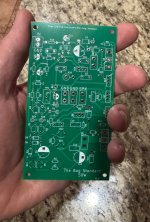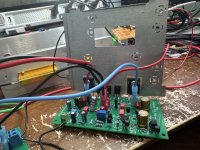It’s alive! Running it on crappy lab supplies, so the numbers aren’t amazing yet. But it amplifies a signal! Baby steps! 😀

One of the first things I noticed is a pretty pronounced negative tempco, at least as it relates to bias. I started at approximately 100mA bias current and ran it at about 1W for a few minutes. That lowers the bias current to about 70mA and it stabilizes there. I guess that's better than a positive tempco. I might just have to set the bias a hair higher than desired and let it stabilize. This is with just a piece of sheet metal as a heat sink, but judging from the previous iteration of this amplifier, it will behave similarly on a real heatsink.
I have been working on a similar design for some time. But the VB Multiplier in my design has a TL431 in series with the single transistor of your design. Ie about 3.6 Volts of fixed voltage in series with the VB multiplier. Perhaps as a quick experiment you could at a Blue LED in series with the VB and see if that makes the current more stable.
Attachments
Why don't you strap the outputs to a piece of aluminum or copper plate for testing? I would never start testing with those devices naked in the wind but hey...I don't know but you are asking for trouble? Great progress!It’s alive! Running it on crappy lab supplies...
I finally got a chance to take some measurements. This is running off of two lab supplies with everything just spread out on my workbench without any regards to proper grounding etc. Also, it's measured through a cheapo Behringer sound card that I think adds 0.005% of dist. I think with a proper supply, wiring and a better measurement setup, I should get an order of magnitude better numbers. As you can see, there's some noise and hum, which I attribute to the rats nest of a setup I have at the moment.
The measurement is taken at 1W with about 100mA of bias current.
Nonetheless, 0.01% is decent starting port for work from. And I'm not sure 0.01% is even audible. But I'm aiming for 0.001%.
I have a QuantAsylum audio analyzer on my wish list and maybe I feel like rewarding myself... That should get us some more accurate data.

The measurement is taken at 1W with about 100mA of bias current.
Nonetheless, 0.01% is decent starting port for work from. And I'm not sure 0.01% is even audible. But I'm aiming for 0.001%.
I have a QuantAsylum audio analyzer on my wish list and maybe I feel like rewarding myself... That should get us some more accurate data.
Made some small adjustments and got another zero! 😀 I think I'm limited by the performance of my test gear at this point. How am I going to sneak an audio analyzer past my wife? 😀

A good speaker system will generate 1% distortion or more, any day of the week.
The more decimal positions added to a distortion percentage measured on a preamplifier or power amplifier, the more I dislike the item sonically.
It is a fun game to pursue 0.00000001% THD but I always hate the sound of those pieces. Almost every time.
The more decimal positions added to a distortion percentage measured on a preamplifier or power amplifier, the more I dislike the item sonically.
It is a fun game to pursue 0.00000001% THD but I always hate the sound of those pieces. Almost every time.
Frequency response by manually eyeballing the scope and entering into a spreadsheet. 3dB down at 900kHz. Still plenty of gain at 10Hz due to the oversized (33uF) input capacitor. I'll probably get better distortion numbers if I reduce that cap.
I can't crank it up all the way to max power until I've mounted it on its permanent heatsink, but the slew rate is >20V/us (and then some).

I can't crank it up all the way to max power until I've mounted it on its permanent heatsink, but the slew rate is >20V/us (and then some).
Hehehe, welcome to DIYAudio!A good speaker system will generate 1% distortion or more, any day of the week.
The more decimal positions added to a distortion percentage measured on a preamplifier or power amplifier, the more I dislike the item sonically.
It is a fun game to pursue 0.00000001% THD but I always hate the sound of those pieces. Almost every time.
This whole area both interests and irks me no end.
It seems to happen all the time.
Speakers mostly produce low harmonics. The go-to recipe of high OL gain + feedback ratio in power amplifiers produces a mostly flat spectrum of harmonics. Fletcher-Munsen and related hearing sensitivity charts consistently show a good 20dB higher sensitivity in the mid-high frequencies around 2-4kHz, suggesting that "THD" should really be weighted to give around 10× or a 20dB penalty in that area (and that's not counting subjective sensitivity to distortion either, just a 1st estimate on how audible it should be, with no assumptions about preference.)
In any case, without diving too deep, I think it's important to consider the speaker type and its operating principles, and the amplifier can be designed around it, possibly reducing distortion by a sizeable factor.
I connected it to a speaker for the first time and it sounds... well... great! The best way I can describe it is "clean". All the aspects of the music come though. Nothing more, nothing less. No harshness. Just crispness. I know that's not everybody's cup of tea, but that's how I like an amplifier. A wire with gain.
I think it passed the test for me to build the other channel so I can do some real listening tests.
I think it passed the test for me to build the other channel so I can do some real listening tests.
Hmm, tell her it's a new Wi-Fi router? 😁Made some small adjustments and got another zero! 😀 I think I'm limited by the performance of my test gear at this point. How am I going to sneak an audio analyzer past my wife? 😀
View attachment 1425996
- Home
- Amplifiers
- Solid State
- "The Bog Standard" - A good enough amplifier for the rest of us

